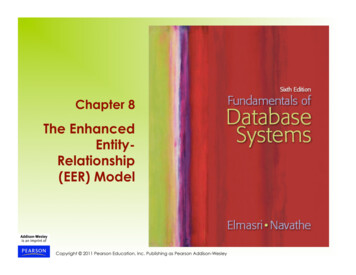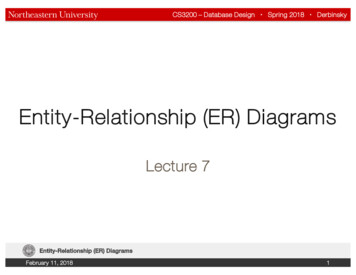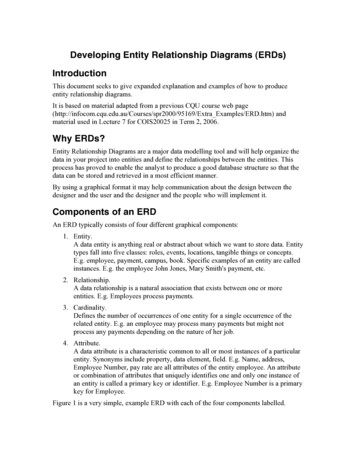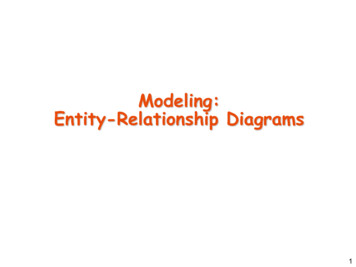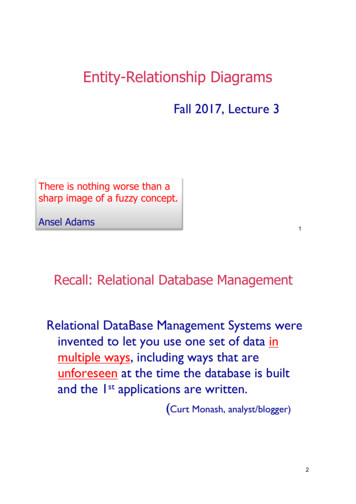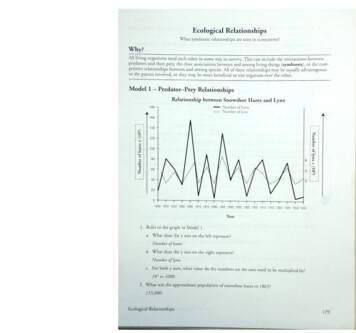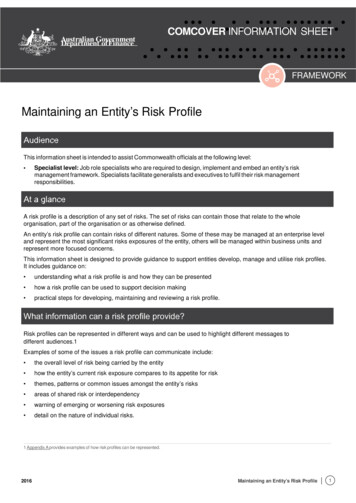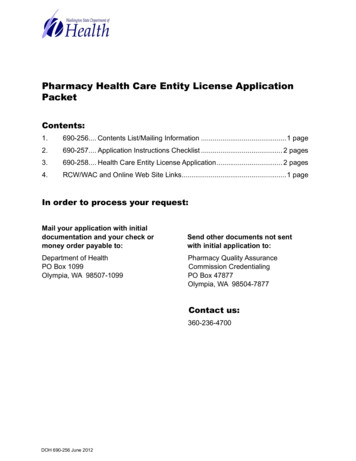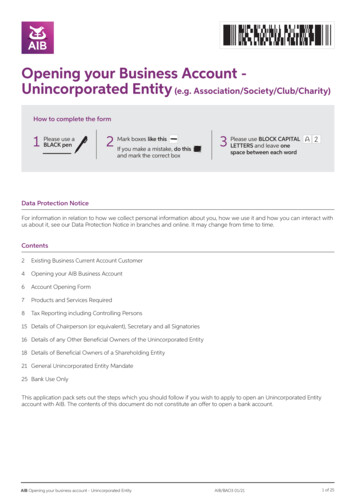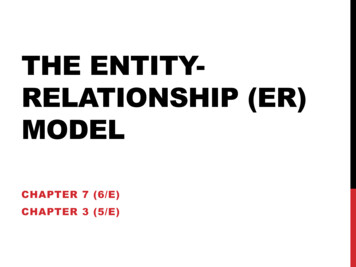
Transcription
THE ENTITYRELATIONSHIP (ER)MODELCHAPTER 7 (6/E)CHAPTER 3 (5/E)
LECTURE OUTLINE Using High-Level, Conceptual Data Models for Database Design Entity-Relationship (ER) model Popular high-level conceptual data model ER diagrams2 Diagrammatic notation associated with the ER model
STEPS IN DATABASE DESIGN Requirements collection and analysis DB designers interview prospective DB users to understand anddocument data requirements Data requirements Functional requirements of the principal applications Conceptual or logical DB design Description of data requirements Detailed descriptions of components and constraints Transformed into implementation data model Result: DB schema in implementation data model of DBMS Physical DB design Internal storage structures, file organizations, indexes, accesspaths, and physical design parameters for the DB files3 External or view design
A SAMPLE DATABASE APPLICATION Requirements gathered for COMPANY 4Employees, departments, and projectsCompany is organized into departmentsDepartment controls several projectsEmployee: require each employee’s name, Social Security number,address, salary, sex (gender), and birth date Keep track of the dependents of each employee
ER MODEL OVERVIEW ER model describes data in terms of: Entities and entity sets Objects Relationships and relationship sets Connections between objects Attributes5 Properties that characterize or describe entities or relationships
6ENTITIES AND ATTRIBUTES EXAMPLE
ENTITY SETS Entity type or set Collection (or set) of similar entities that have the same attributes ER model defines entity sets, not individual entities7 But entity sets described in terms of their attributes
CATEGORIES OF ATTRIBUTES Simple (atomic) vs. composite attributes Single-valued vs. multivalued attributes Stored vs. derived attributes Key or unique attributes8 Attribute values constrained to be distinct for individual entities inentity set
INITIAL ER DIAGRAM FOR COMPANY Four entity types Most attributes are simple, single-valued, and stored Works on and Locations are multivalued Employee’s Name is composite9 Employee has one key, department and project have two keys,dependent has none
WEAK ENTITY TYPES Entity types that do not have key attributes of their own Identified by their relationship to specific entities from another entitytype Dependent is meaningless inCOMPANY DB independentlyof Employee Identified by relationship toEmployeeDependent name distinguishesone dependent from otherdependents for the sameemployee: partial key11 Identifying relationship Relates a weak entity type to the identifying entity, which has therest of the key
RELATIONSHIPS IN GENERAL Relationship Interaction between entities Indicator: an attribute of one entity refers to another entity12 Represent such references as relationships not attributes
RELATIONSHIPS Relationship Interaction between entities Indicator: an attribute of one entity refers to another entity Represent such references as relationships not attributes Relationship type R among n entity types E1, E2, ., En Defines a set of associations among entities from these entity types Relationship instance ri Each ri associates n individual entities (e1, e2, ., en) Each entity ej in ri is a member of entity set Ej Relationships uniquely identified by keys of participating entities Degree of a relationship type13 Number of participating entity types e.g., binary, ternary
14RELATIONSHIPS & RELATIONSHIP SETS
DIAGRAMMING RELATIONSHIP TYPE Diamond for relationship type Connected to each participating entity type Could be binary, ternary, or higher degree Remember:15 Represents a set of entities of each type,some of which are related to entities of theother type(s) Some entities might participate in severalrelationships Some entities might not participate in therelationship at all
RELATIONSHIPS WITHREPEATED ENTITY SETS Some relationships involve multiple entities from the same entity set e.g., spouse (two persons), games (two teams) e.g., recursive relationships, such as supervises (two employees) Role name16 Signifies role that participating entity plays in relationship instance Required when entity type participates multiple times in arelationship
17USING ROLE NAMES
RELATIONSHIP CONSTRAINTS Cardinality ratio Specifies maximum number of relationship instances in which eachentity can participate Types 1:1, 1:N, or M:N Participation constraint Specifies whether existence of entity depends on its being related toanother entity Types: total and partial Thus minimum number of relationship instances in which entities canparticipate: thus1 for total participation, 0 for partial Diagrammatically, use a double line from relationship type to entitytype Alternative: Structural constraint Generalization: specifying any min and max participation Replaces cardinality ratio numerals and single/double line notation18 Associate a pair of integer numbers (min, max) with each participationof an entity type E in a relationship type R, where 0 min max andmax 1 max N finite, but unbounded
RELATIONSHIP ATTRIBUTES Relationship types can also have attributes Property that depends on both/all participating entities Example: Percentage of control that department has on a projectCONTROLSPercent Attributes of 1:1 or 1:N relationship types can bemigrated to one of the participating entity types19 For a 1:N relationship type, relationship attribute can be migratedonly to entity type on N-side of relationship Attributes on M:N relationship types must be specified asrelationship attributes
SUMMARY OF ER DIAGRAM SYMBOLS20 1 E1 entity can be related to N E2 entities
REFINING EXAMPLE ER DESIGN Recall preliminary ER design Change attributes that reference entity types into relationship types Weak entities use identifying relationship Weak entity type always has structural constraint of (1,1)participation in identifying relationship21 Determine cardinality ratio and participation constraints for eachrelationship type
22
23
APPROPRIATE ER MODEL DESIGN Choose names that convey meanings attached to variousconstructs. Nouns give rise to entity type names Verbs indicate names of relationship types Choose binary relationship names to make ER diagram readablefrom left to right and from top to bottom Review all attributes Refine into a relationship if attribute references an entity type Attribute that exists in several entity types may be better modelledas an independent entity type25 Entities that must participate in a relationship with another entitytype and with cardinality constraint of 1 might be better modelled asweak entity
26REVIEW HIGH-DEGREE RELATIONSHIPS
LECTURE SUMMARY Components of the Entity-Relationship Model Entity Types, Entity SetsWeak Entity TypesRelationship Types, Relationship Sets, RolesAttributes, Attribute Classification, KeysStructural Constraints ER diagrams represent ER models28 Appropriate ER design
Example: Percentage of control that department has on a project Attributes of 1:1 or 1:N relationship types can be migrated to one of the participating entity types For a 1:N relationship type, relationship attribute can be migrated only to entity type on N-side of relationship Attributes on M:N relationship types must be specified asFile Size: 770KBPage Count: 25

